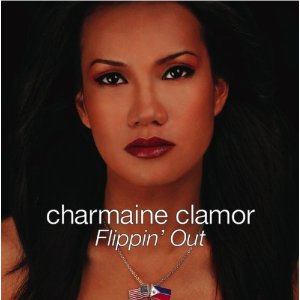CHARMAINE CLAMOR / “Charmaine Clamor Mixtape”
From 1492 on, white supremacy was imposed as the law of all lands worldwide. And long after slavery, colonialism and legal segregation have been formally eradicated the psychological impact of white supremacy still reigns.
Some may think this is, shall we say, an interesting way to introduce a female jazz vocalist.
Paging Dr. DuBois. Is there a doctor in the house? Is there any cure for the complex of non-white peoples viewing themselves as inferior? It’s well after the twentieth century and we are still victims of the color line.
What do you mean Kalamu?
I mean listen to Charmaine Clamor.
 Who?
Charmaine Clamor. A jazz vocalist from the Philipines. Her family moved to Los Angeles when Charmaine was a teen. Charmaine excelled in school. She was her high school’s valedictorian. She earned a Masters Degree in Physical Therapy from Cal State-Northridge.
As a child she grew up not only enjoying music but also taking music lessons and eventually accompanying her mother who sang traditional Philipine romance songs called kundiman as well as American standards.
Who?
Charmaine Clamor. A jazz vocalist from the Philipines. Her family moved to Los Angeles when Charmaine was a teen. Charmaine excelled in school. She was her high school’s valedictorian. She earned a Masters Degree in Physical Therapy from Cal State-Northridge.
As a child she grew up not only enjoying music but also taking music lessons and eventually accompanying her mother who sang traditional Philipine romance songs called kundiman as well as American standards.

My parents exposed me to beautiful music early on: opera, jazz, the Great American Songbook, Kundiman and Harana. Kundiman and Harana are analogous to the Great American Songbook. They're our classic music, with elegant lyrics and timeless melodies. Kundiman is a Filipino torch song and Harana is a serenade song. They're both unashamedly sentimental. If done insincerely, some might find them corny. If done sincerely, they're deeply moving -- just like our very best songs by Porter, Gershwin and Kern. The Harana is a beautiful, old-fashioned tradition. In the golden days of the Philippines, before text messaging was born, when a young man fancied a Filipina, he would go to her house at night with a guitar and serenade her with a “Harana” song underneath her window. If the lady liked what she heard, the windows would magically open. If she didn't, the windows stayed shut all night. So you've got to sing it right. —Charmaine ClamorOnce she decided to pursue music as a career after quitting a good job as a physical therapist, Charmaine quickly established herself as the leading jazz vocalist from the Philipines. Both her first and second albums entered the top ten on jazz and world music radio playlists. Even a cursory listen to her music reveals two things. One, she swings. Two, she’s not just copying what other singers have done. Indeed, Charmaine created a new genre of music that she calls jazzipino: a blend of straight ahead jazz and soul music with traditional Filipino folk music, languages and instruments.
 Plus, she intentionally confronts the legacies of white supremacy in terms of skin color, physical features, and standards of beauty, particularly for women.
Plus, she intentionally confronts the legacies of white supremacy in terms of skin color, physical features, and standards of beauty, particularly for women.
Since our country was conquered by the Spanish for many, many years, the Filipinos, the native ones, lost pride in their indigenous beauty. “My Funny Brown Pinay” celebrates the unique attributes of an indigenous Filipino woman: someone who has a flat nose, black hair, dark skin, brown skin. And this is what I’m trying to communicate to my Pinay sisters. —Charmaine Clamor It's an anthem of pride. I was raised in a culture that is in many ways still feeling the effects of colonial occupation. The key phrase -- "Don't change your hair for me, stay" -- summed up my feelings about my Filipina sisters. You know, it wasn't until I came to America that anyone thought I was attractive, because in the Philippines, everyone is trying to erase their brown skin with lightening creams and soaps. I would pinch the bridge of my flat nose to try and make it pointy. I'm hoping this song -- and my life -- can be an example to women back home: "Maganda ka -- you are beautiful!" —Charmaine ClamorOf course, ultimately, with music we want to know how it sounds. You can judge for yourself. I’m digging it. I like her sense of rhythm and also how she comes up with original arrangements plus mixes in melodic snippets and quotes from different songs, much like Sonny Rollins does when he plays standards. Listen to her stirring interpretation of Duke Ellington's "Come Sunday."Charmaine makes the song sound like Duke wrote it for the Filipino people. One of the great beauties of black music is that the form is so adaptable to widely varying social realities and at the core of the music is a strong yearning for freedom of self expression. Given the worldwide extent of oppression and exploitation there should be no surprise that a music whose core is freedom should continue to resonate with peoples around the world. The music of Charmaine Clamor is a great example of the value of black music. In turn Charmaine enriches the legacy of the music by bringing in forms that previously were not included. Afterall this is what all of the great jazz artists have done. They incorporated diverse influences into a unique artform that is both instantly identifiable and yet infinitely expansive. Filipinos will listen to Charmaine and be made proud by someone who is promoting their culture. The rest of us will listen to Charmaine and hear a genuine jazz singer who is bringing something unique to the artform. Fair exchange is no robbery. Enjoy Charmaine Clamor, a brilliant artist and advocate of jazzipino music. —Kalamu ya Salaam Charmaine Clamor Mixtape Playlist
 Searching for the Soul
01 “Neither One of Us”
02 “Since I Fell for You”
03 “It Don't Mean a Thing (If It Ain't Got That Swing”
04 “The Nearness of You”
05 “My Romance”
06 “The Very Thought of You/Tenderly”
07 “Come Sunday”
Searching for the Soul
01 “Neither One of Us”
02 “Since I Fell for You”
03 “It Don't Mean a Thing (If It Ain't Got That Swing”
04 “The Nearness of You”
05 “My Romance”
06 “The Very Thought of You/Tenderly”
07 “Come Sunday”
 Flippin' Out
08 “My Funny Brown Pinay”
09 “Minamahal Kita”
10 “I Need a Lot of Love”
11 “Dahil Sa'yo”
Flippin' Out
08 “My Funny Brown Pinay”
09 “Minamahal Kita”
10 “I Need a Lot of Love”
11 “Dahil Sa'yo”
This entry was posted on Monday, July 5th, 2010 at 2:29 am and is filed under Contemporary. You can follow any responses to this entry through the RSS 2.0 feed. You can leave a response, or trackback from your own site.
One Response to “CHARMAINE CLAMOR / “Charmaine Clamor Mixtape””
July 5th, 2010 at 12:57 pm
What a beautiful tribute to a beautiful and groundbreaking artist!
Thank you, kalamu.
Leave a Reply
| top |